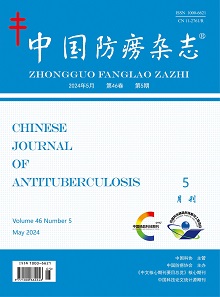Select
Spatial and temporal distribution characteristics and correlation analysis of HIV/AIDS and tuberculosis in Liangshan Yi Autonomous Prefecture, Sichuan from 2013 to 2019
LI Jing, YUAN Feng-shun, LI Ting, LI Yun-kui, GAO Wen-feng, YANG Cheng-bin, HE Jin-ge, YANG Wen
Chinese Journal of Antituberculosis
2021, 43 (7 ):
708-715.
DOI: 10.3969/j.issn.1000-6621.2021.07.012
Objective To compare the temporal and spatial distribution of reported cases of HIV infection and AIDS (HIV/AIDS) and tuberculosis in Liangshan Yi Autonomous Prefecture (Liangshan Prefecture) in Sichuan from 2013 to 2019, and analyze the temporal and spatial correlation of the two diseases and the hot areas of the disease, so as to provide reference for formulating prevention and control strategies. Methods Numbers of reported HIV/AIDS and tuberculosis cases between 2013 and 2019 were collected from internet-based reporting system of Chinese Center for Disease Control and Prevention. The temporal and spatial correlation of the two diseases was analyzed by simple correlation, linear regression and spatial autocorrelation. SPSS 23.0 software was used to analyze the simple correlation and linear regression, ArcGIS 10.0 software was used to analyze the global spatial autocorrelation and local spatial autocorrelation, and the dual variable spatial autocorrelation analysis was carried out using GeoDa 1.1.4 software. Results HIV/AIDS and tuberculosis patients were reported from all the 17 counties (districts) in Liangshan Prefecture. The numbers in each year were 4139, 4406, 4005, 4802, 5570, 10105 and 4694, respectively, and the increasing rates were 6.5%, -9.1%, 19.9%, 16.0%, 81.4% and -53.5%, respectively. Numbers of reported tuberculosis cases in each year were 4590, 4323, 4453, 5931, 6748, 6432 and 6893, respectively, and the increasing rates were -5.8%, 3.0%, 33.1%, 13.8%, -4.7% and 7.2%, respectively. The results of linear regression analysis showed that the correlation coefficient (rs ) between numbers of reported cases of HIV/AIDS and tuberculosis in Liangshan Prefecture according to a linear distribution with the year (x ). The linear regression equation was: rs =-106.602+0.53x (regression coefficient test: t =3.109, P =0.027), the goodness of fit was average (determination coefficient R 2 =0.659, correction coefficient R 2 =0.591). Global spatial autocorrelation analysis showed that there was a positive spatial correlation between the reported incidence of HIV/AIDS from 2013 to 2018 (Moran’sI values were 0.213, 0.194, 0.342, 0.368, 0.271 and 0.180, respectively; P values were 0.028, 0.033, 0.003, 0.002, 0.008 and 0.027, respectively); the reported incidence of tuberculosis from 2013 to 2019 had a positive spatial correlation of medium degree and above (Moran’sI values were 0.374, 0.500, 0.451, 0.347, 0.487, 0.472 and 0.532, respectively; all P <0.05). Local spatial autocorrelation analysis showed that, from 2013 to 2018, Zhaojue County, Butuo County, and Jinyang County in Liangshan Prefecture were hot spots for reported cases of HIV/AIDS. From 2013 to 2015, the hot spots for tuberculosis were mainly concentrated on Leibo County, Meigu County, and Jinyang County; Ganluo County was a hot spot from 2015 to 2017; Zhaojue County became the hot spot in 2014 and had continued to be a hot spot since 2016, and it had spread to Yuexi County. The bivariate global spatial autocorrelation analysis showed that the reported incidence of HIV/AIDS and tuberculosis were positively correlated from 2013 to 2019 (Moran’sI values were 0.312, 0.345, 0.385, 0.419, 0.388, 0.345 and 0.293, respectively; all P <0.05). Conclusion There was a strong positive correlation between HIV/AIDS and tuberculosis reported cases in the temporal and spatial distribution, which suggested that Liangshan Prefecture should pay equal attention to the two diseases in the prevention and control of these two infectious diseases, close combination were needed, the diagnosis and treatment of HIV/AIDS and tuberculosis patients should be improved, the prevention and control measures for key areas and groups should be strengthened, and the diagnosis, treatment and health care should be improved.
Table and Figures |
Reference |
Related Articles |
Metrics

 Wechat
Wechat